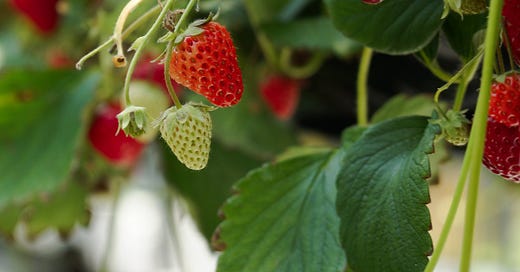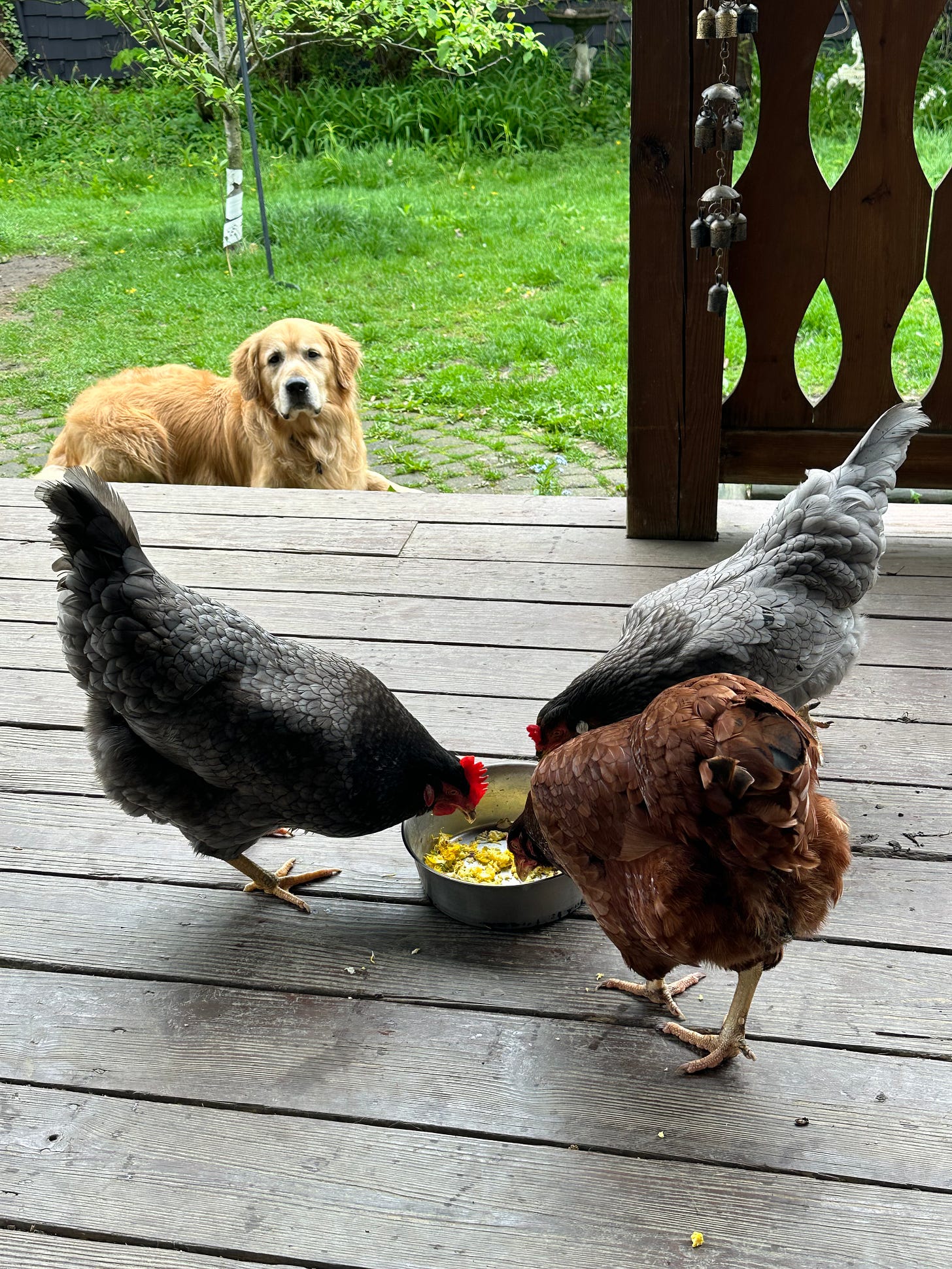“In the spring, at the end of the day, you should smell like dirt.”
—Margaret Atwood
I was at the store last week, just grabbing a few basics, when I caught sight of them—strawberries. Piled high in those familiar clamshell containers, bright red and perfectly shaped, with a cheerful little sign that read Sweet and Juicy! As tempting as they were and trust me, as one who spent a lifetime in marketing I am the easiest person to sell ANYTHING to…I walked right past them.
Because I can’t eat strawberries in April.
Not here. Not where I live.
In Northeast Ohio in April, the ground is still waking up. My grapevines are just beginning to unfurl, tender and tentative, and the wild greens are coming in strong—nettles, chickweed, dandelion, garlic mustard. The air still has a chill, and the chickens are busy fluffing and fussing in the garden, thrilled by the return of worms in the thawed soil. But strawberries? Real strawberries? They’re not ready yet.
When you live seasonally, you start to feel these rhythms in your bones. You know that strawberries belong to late spring, to warm mornings and buzzing bees. Not to cold trucks and plastic packaging. You can taste the difference—sun-warmed, field-ripe fruit doesn’t just feed you, it reminds you of who you are and where you are.
And yet—I’ll admit something here.
There are strawberries in my kitchen in April.
Just not the kind you buy in plastic from across the country.
Mine were picked in June, warm from the sun and bursting with sweetness. I picked them with my grandson Wolfie, which makes them doubly sweet! Together we sliced them, laid them gently into bags, and tucked them into the freezer like little bags of sunlight. Same with the sweet ripe peaches in July from our little tree, the sweet corn in August, the summer squash that comes in faster than you can eat it.
And yes, sometimes I eat sweet corn in February.
But only the kind I picked myself from the farmers market with care —shucked and blanched at the peak of its sweetness, then frozen with care. When I steam it in the middle of winter with buttermilk and honey, the scent alone brings summer rushing back to me.
That’s the thing. When you’ve grown it yourself, or preserved it at its best, you can taste the season again—even out of season.
It’s not just about when you eat something, it’s how it came into your kitchen.
I used to ignore the seasons entirely when it came to eating. I’d buy tomatoes in winter and winter squash in high summer, because I could. Because it was all there, all the time. But the food never really satisfied me. It filled me up, sure—but it didn’t nourish. Not in the way I know now.
When I started raising chickens and growing more of our food, something shifted. The eggs from my girls—deep golden yolks, full of flavor—ruined me for the store-bought kind and here’s the thing…mostly they stop laying as soon as the light changes and it gets colder, so you’ve got to find other things to eat for breakfast. Same with the lettuces, the herbs, the fresh asparagus that only comes once a year, for a short and glorious stretch. I began to see food not as an easy commodity, but as a conversation between me and the land. One that changes with the light, with the weather, with the seasons.
And here’s the beautiful truth: you don’t need a garden to live this way. You can find the rhythm of the seasons at your local farmers market—just by showing up, week after week. Talk to the people who grow your greens, gather your eggs, raise your meat. Ask what’s coming into season, what’s fading out. Let their hands and stories become part of your meals. Eating this way is about connection, not perfection. It’s about supporting the people who still listen to the land—and letting that wisdom feed you, too.
Seasonal eating, for me, isn’t a rule—it’s a way of returning.
In spring, I crave bitter greens and cleansing broths. In summer, it’s cucumbers, berries, and herbs. Fall brings squashes and earthy roots, potatoes pulled from the ground while the air turns gold. And winter is for slow meals, bone broth, and the kind of soups that taste better the second day.
And of course, oysters.
Only in the “R” months, as my friends know well. September through April, I’m all in—on the half shell, in stews, baked with a little wild fennel or tucked into a gratin. But come May? I close that chapter until the cooler tides return. It’s not superstition—it’s sensibility. The ocean has its own rhythm too.
It’s not just that these foods grow best in those seasons—they make sense to our bodies in those seasons. The earth is wise that way. She gives us what we need, when we need it.
So no, I didn’t buy the strawberries in April. I’ll wait for the ones that come at the right time, in the right place. And when they do, I’ll slice them warm from the sun, stir them into cream, or layer them over a simple cake and call it a celebration.
Because seasonal food isn’t just better for your health. It’s better for your soul.
And when you’ve tended it, preserved it, and brought it forward with care—it can carry that soulfulness into every season.
With love from my table to yours,
Beth
P.S. If this reflection nourished something in you, I’d love to welcome you as a paid subscriber. Every other week, I share new chapters from my book-in-progress, Forage & Gather— as well as stories, recipes, and old wisdom that celebrate the beauty of living in season. Your support makes this work possible, and it means the world to me.
“When you eat in season, you’re not just feeding your body—you’re coming home to the world.”
—Forage & Gather








